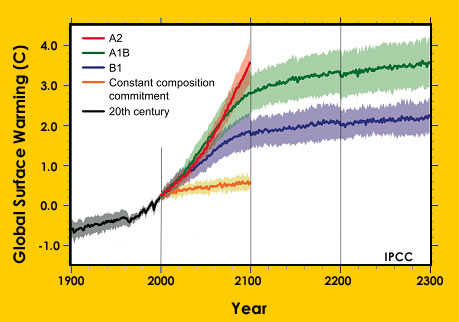This image, taken by the MODIS sensor on the Aqua satellite, shows the temperatures of California and Nevada during a spring heat wave in May 2004. MODIS (Moderate Resolution Imaging Spectroradiometer) measures the land temperature, which can get much warmer than the air. Notice that the tops of the Sierra Nevada mountains, which were still capped with snow, remain cool, forming a blue line at the California-Nevada border.
Click on image for full size
Courtesy of NASA
Heat Waves
It’s the middle of the summer and it’s hot – hotter than normal. The heat lasts for days. It’s hot at night too.
Unusually hot summer weather that lasts for several days is called a heat wave.
Not all heat waves are the same. Some have high humidity. Others do not. Some last for a week or more. Others last only a few days. Heat wave temperatures will be much hotter in a region that is usually hot than in a region that is usually cool. For example, temperatures during a heat wave in southern California, where summers are usually hot, may climb to 100-130°F (38-54°C), while temperatures during a heat wave in London, England, where summers are usually mild, may only be 90-95°F (32-35°C).
Heat waves are a danger to human health – causing heat stroke, heat exhaustion, cramps, and other ailments. They are hazardous to plants as well and can cause crops to fail. Wildfires can also be started during a heat wave in dry areas.
Heat waves can form in many ways. They often form when a warm, high pressure system stalls in a region. Variations in the location of the jet stream, a flow of air that steers the movements of high and low pressure areas through the mid-latitudes, can bring the unusually warm air into a region, causing a heat wave. The heat is able to persist if there aren't rain and clouds to cool things off. The heat-trapping ability of cities, known as the urban heat island effect, can make a heat wave warmer and longer too.
Global warming is causing more heat waves. According to the Intergovernmental Panel on Climate Change 4th Assessment Report, published in 2007, the number of heat waves has risen, especially in Europe and Asia, and heat waves are expected to become more common during the 21st Century.
Last modified July 15, 2009 by Lisa Gardiner.
You might also be interested in:

Rain is precipitation that falls to the Earth in drops of 5mm or greater in diameter according to the US National Weather Service. Virga is rain that evaporates before reaching the ground. Raindrops form
...more
An urban heat island is a metropolitan area that is significantly warmer than nearby rural areas. Many cities have air temperatures 2 - 5°C (3.6 - 9°F) warmer than the surrounding natural land cover. This
...more
Earth’s climate is warming. During the 20th Century Earth’s average temperature rose 0.6° Celsius (1.1°F). Scientists are finding that the change in temperature has been causing other aspects of our planet
...more
"Though we often take the plants and trees around us for granted, almost every aspect of our lives depends upon them. They feed us, cloth us, absorb carbon dioxide, provide us with oxygen, and give us
...more
The world's surface air temperature increased an average of 0.6° Celsius (1.1°F) during the last century according to the Intergovernmental Panel on Climate Change (IPCC). This may not sound like very
...more
Looking for online content that can be used for a climate change education course or module? Pages linked below can be used to support an introductory climate change education for either a unit or a full
...more
Rainbows appear in the sky when there is bright sunlight and rain. Sunlight is known as visible or white light and is actually a mixture of colors. Rainbows result from the refraction and reflection of
...more















